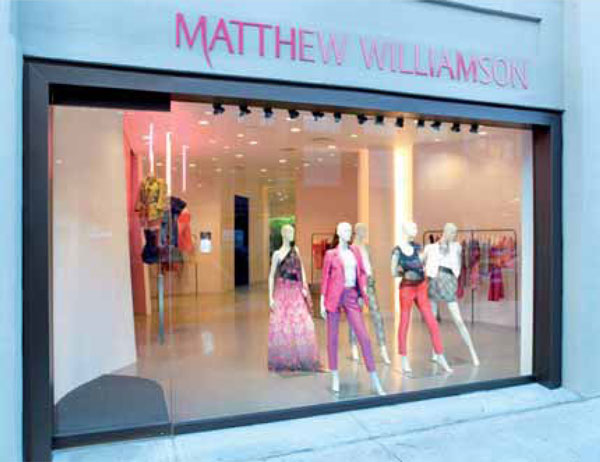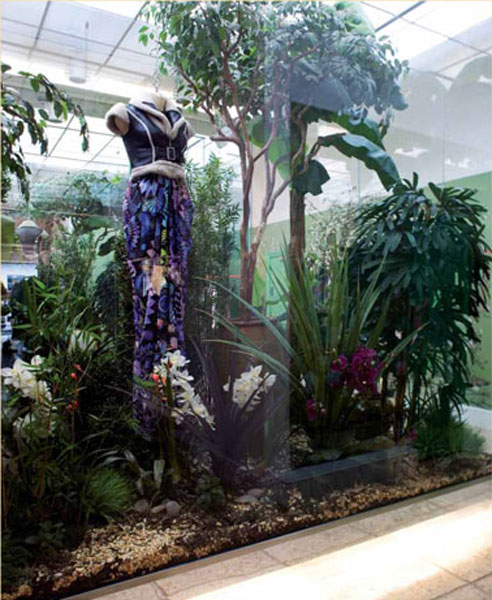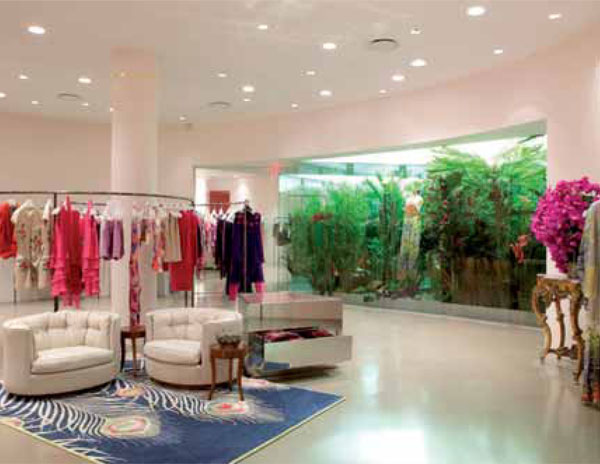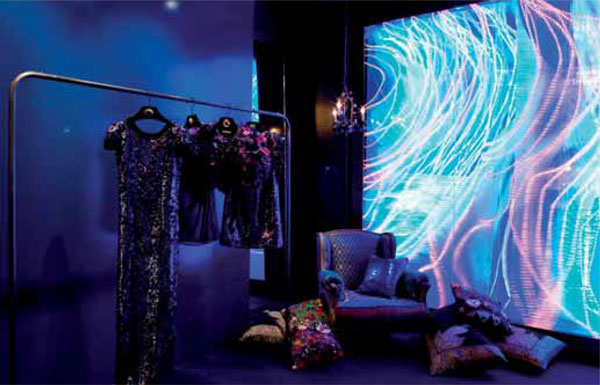Store study: Matthew Williamson

The exterior of Matthew Williamson’s store is simple but elegant. Once inside, the customer is led into different themed areas, each one characteristic of Williamson’s brand.
British designer Matthew Williamson graduated from Central Saint Martins, University of the Arts, London, in 1994. His creativity was noted by Italian design house Marni, where he worked as a freelance designer. He then moved to British retailer Monsoon and Accessorize. Not content with working under the constraints of others, Williamson launched his own collection of couture fashion in February 1997. His success not only as a designer but also as a retailer has made his collections desirable to the rich and famous. His clientele includes A-list celebrities such as Beyoncé and Kate Moss. He opened his first stand-alone store in Mayfair’s Bruton Street, London, in March 2004 and has since opened stores in New York’s fashionable Meatpacking District and recently in the Dubai Mall, Dubai.
Williamson’s eye for detail stretches farther than his embellished and colorful designs that are seen on the runway—he has been able to translate his innovative design concepts into his store design. His stores boast vibrant hues, exquisite detail, and a huge amount of embellishment.
How important is store design in the twenty-first century? Do you feel that it helps to promote a brand’s identity?
“I opened my first store in London in 2004. Until then I had to be content with having people view my collections within spaces that did not reinforce my design aesthetic, or at least complement them. Having a custom-designed space is a powerful tool for any brand; it delivers the whole lifestyle, which allows people to comprehend fully what the label is about. Opening stores in New York and Dubai undoubtedly helped shape people’s perception of the brand and bolstered our reputation in the territory.”
Your store design has complete empathy with your clothes. Was it challenging to design stores to showcase your work?
“Designing stores has definitely been a labor of love. With each one I wanted to create a space that fused together elements that I habitually use as themes within my collections to ensure that they were displayed in an engaging way. The challenge came in the translation of those themes from fashion design into interiors without being too literal, but I am happy with the balance I found. For example, the intricate embroidery and beading found on MW garments is reflected in the delicate vintage brooches that adorn the wallpapered areas of the stores and within the changing rooms.”

An indoor exotic garden is the centerpiece of Matthew Williamson’s London store, creating ambience and a sense of theater.

Williamson’s trademark indoor jungle acts as an impressive backdrop to his New York store.
Did you have a vision of how your stores should look? What was your inspiration behind the store design?
“From a very early age I had a clear idea that my store would have a fuchsia-pink sign above it, but other than that my ideas were undefined until I had chosen the first store space. The London store concept evolved organically in some ways, with aspects of the building itself—such as the natural light well at the rear of the space—inspiring the encased tropical jungle.
The New York and Dubai store designs took inspiration from their immediate surroundings while retaining the brand’s signature as dictated by the first flagship.
In New York, the industrial feel of the Meatpacking District is evident throughout in the clean line and through the materials used, such as the poured concrete flooring. Here, as with London, the design was influenced by the very building itself. The space here is long and narrow and punctuated by a central column of iron supports. Instead of fighting against them, we embraced them as markers of smaller, cocoon-like rooms within the store. The result was a store design that draws customers on a journey through the space and one that also allows for greater freedom in merchandising, or for highlighting certain parts of the ready-to-wear collections.
The Dubai store was also heavily influenced by the region. The rotunda and punched starred ceiling are examples of this, as is the domed section of the store. I wanted to reflect not only the culture of the surrounding environment but also take some inspiration from traditional craftsmanship, as demonstrated in the intricate fretwork.”
How did you ensure that the colorful and detailed designs of your stores would not overshadow your collections?
“When working with bold prints and a vivid color palette there is a danger of allowing them to become overpowering within the space. However, I feel that the stores achieve a happy balance, with accents of color or embellishment within more neutral spaces. I also incorporate a lot of mirrored surfaces within the stores, which open up the space to disperse the feeling of being overwhelmed.”
You are renowned for your confident use of color and prints. Was this a major design factor that you considered when planning your first store?
“I wanted to explore the juxtaposition of old and new in the materials with which I chose to furnish the store, so we have antique Venetian glass chandeliers hanging above neon signage. This idea of unexpected combinations is also encapsulated in what I call ‘hyper-nature,’ where the synthetic meets the natural. I used the existing pale and powdery marble flooring of the building as a contrast to the oversized, bold-pink till area for a striking focal point in the space. Elsewhere, traditional deGournay chinoiserie wallpaper was dramatized with accents of neon, which I personally handpainted.”
You have produced some crazy window displays. How does a dinosaur devouring a mannequin in one of your dresses promote sales? (I loved the window, by the way—very clever!)
“The window displays are something I have always been proud of, and I have a team of inspired people who work with me to generate these wonderful displays. I think that in their essence, the displays are there to capture the imagination of passersby and encourage them to notice both the store and the garments. Matthew Williamson customers are defined by their confident nature and a sense of flamboyance in their personal style, and they would appreciate the tongue-in-cheek approach.”

Dark lighting and a sophisticated color scheme are the theme for this area, which includes a dramatic panel with a contemporary lighting installation.
Do you think that mannequins are useful props to carry your collections?
“Live catwalk shows will always remain the best way to showcase a collection, but realistically a mannequin is the most appropriate option for in-store. Hanging garments rarely convey the nuances of a cut or fit of a piece.”
You always take time to install a complete window scheme. How important are your window displays?
“I direct a team, but as the London store is very close to my studio I often participate in the installation itself, too. The window displays are extremely important to any brand because they are the first impression a client has of the store and the collections. It pays to be flexible in changing installations to suit external or seasonal factors.”
How often do you install a new window scheme?
“We install new window displays around key points in the year to signal to customers that a new range is in, or simply to celebrate fashion week or the winter holidays.”
Whose stores do you enjoy shopping in?
“There is a real sense of theatrics to Kokon To Zai on the Goldborne Road, and I love the fact that this haven of eccentric goods is housed in a former run-of-the-mill butcher’s with the Victorian decoration still intact and very much made a feature of. The mixture of taxidermy, contemporary fashion, and macabre objets d’art is truly an assault on the senses.
Also, true to its name, the variety of designers and artists who are represented in Dover Street Market give a marketplace feel, offering unexpected finds every time I visit. The atmosphere is very inspiring and the strong personal vision of Rei Kawakubo is perceptible through the store.”
What’s next for the Matthew Williamson brand and store design?
“Spring 2011 sees the introduction of the first men’s collection for the brand, so I will be looking at ways to incorporate a specific area into each of the stores to house it. The stores all have a feminine feel to their design, so I am looking forward to the challenge.”
